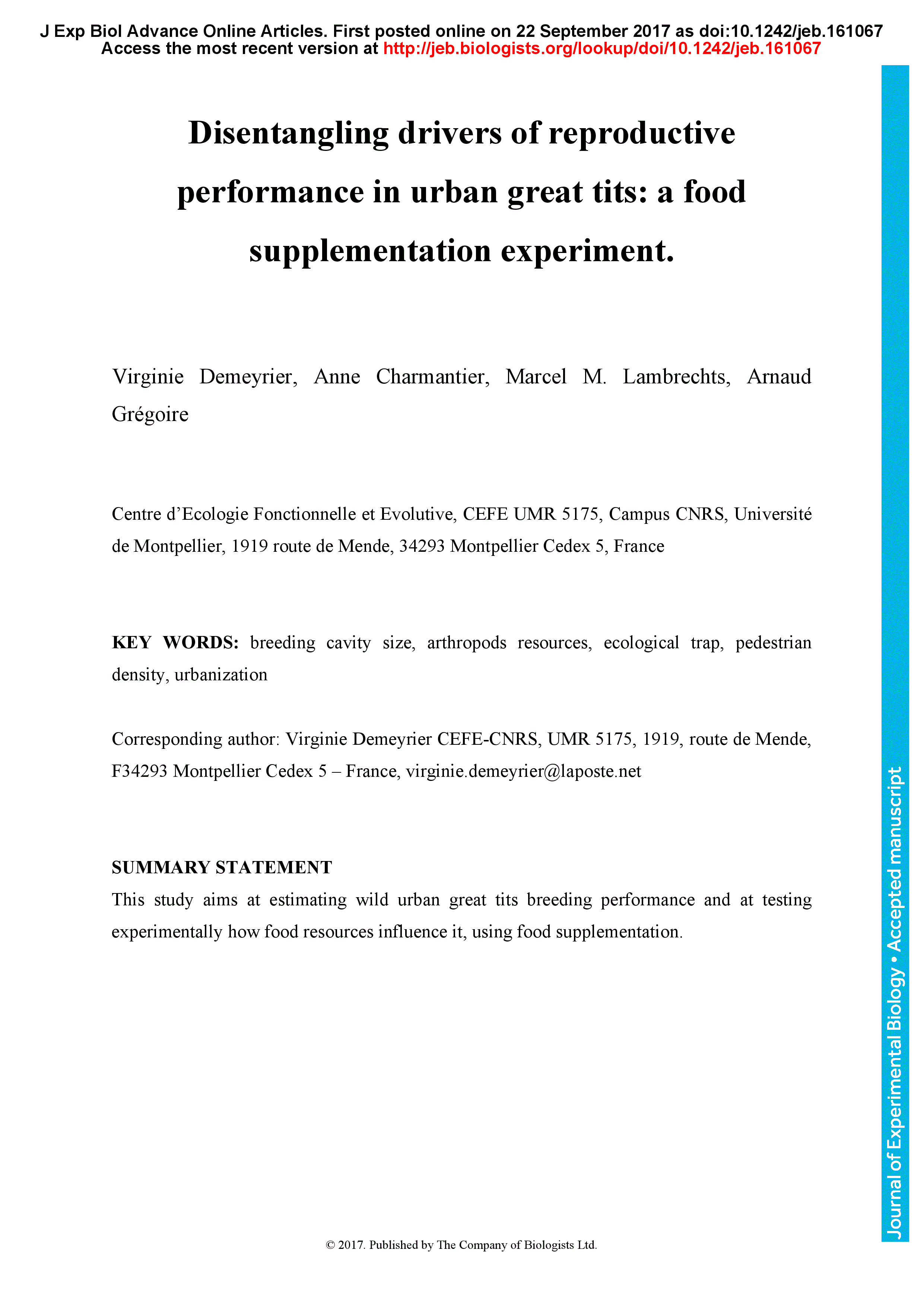Worldwide urban expansion induces degradation of the natural environment, resulting in new constraints in terms of breeding sites, anthropogenic disturbances as well as food resources. The alteration of resource abundance and type may induce non-adaptive investments in reproduction from urban dwellers. Food availability and quality have been identified as potential drivers of the decline in passerine body mass and fledging success in urbanized landscapes, particularly if birds misinterpret cues of food abundance used to adjust their reproductive investment. In a previous study, we demonstrated in urban great tits, Parus major that highly-preferred larger cavities have larger clutches with lower breeding success, leading to a maladaptive breeding investment. Previous studies also showed that urban great tits are smaller or thinner than rural ones, both at nestling and adult stages. Here we present the results of a food-supplementation experiment to examine whether food resources mediate this maladaptive breeding investment and constrain the reproductive performance of this urban bird population. We predicted higher performance in food-supplemented broods, especially in larger cavities, and stronger effects of the supplementation in more artificialized territories. Surprisingly, we found that food-supplemented nestlings and their parents had lower body mass and condition, especially in areas with more pedestrians. Supplementation was also associated with lower nestling survival until fledging in places presenting lower levels of naturalness, independently of cavity size. This work highlights a lack of knowledge on avian feeding behaviour in cities, a key element to understand how breeding performance is affected by human presence and habitat naturalness.
Disentangling drivers of reproductive performance in urban great tits: a food supplementation experiment
Currently Viewing Accepted Manuscript - Newer Version Available
Virginie Demeyrier, Anne Charmantier, Marcel M. Lambrechts, Arnaud Grégoire; Disentangling drivers of reproductive performance in urban great tits: a food supplementation experiment. J Exp Biol 2017; jeb.161067. doi: https://doi.org/10.1242/jeb.161067
Download citation file:
Advertisement
2023 JEB Outstanding Paper Prize shortlist and winner

The JEB Editors are delighted to announce the shortlisted authors for the 2023 JEB Outstanding Paper Prize. Read the winning paper - Tiny spies: mosquito antennae are sensitive sensors for eavesdropping on frog calls - by Hoover Pantoja-Sanchez and Brian Leavell from Ximena Bernal's lab at Purdue University, USA.
JEB Science Communication Workshop for ECRs

If you’re an early-career researcher interested in science communication and are attending the SEB Annual Conference in Prague this summer, come a day early and join the JEB Editors at a sci comm workshop to learn the key writing skills needed to promote your research to a broad audience beyond your peers (1 July at 14.30-17.30). Places are limited to 24 attendees, and applicants should apply through the SEB registration page by 30 April 2024.
Bridging the gap between controlled conditions and natural habitats in understanding behaviour

Novel technologies enable behavioural experiments with non-model species, in naturalistic habitats and with underexplored behaviours. In their Commentary, Scholz and colleagues discuss how to obtain a deeper understanding of the natural ecology and lifestyle of study animals.
Beluga metabolic measures could help save species

To help save animals from extinction, it’s important to understand what each species needs to survive. This led Jason John et al. to measure the metabolic rates of captive belugas to develop a ‘fish calculator’ showing that the whales need to eat ~23 salmon per day.
ECR Workshop on Positive Peer Review

Are you an ECR looking for tips on how to write concise, astute and useful manuscript reviews? If so, join the JEB Editors at a 2-hour JEB-sponsored Workshop on Positive Peer Review at the Canadian Society of Zoologists annual meeting in Moncton on 9 May 2024 at 13.00-15.00. There are 25 spaces for ECRs and selection is first come, first serve. To sign up, check the ECR Workshop box when you register for the CSZ meeting.



